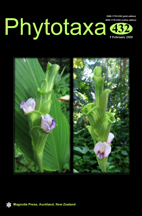Abstract
Inhabiting of bromeliad tanks by algae and other organisms is a very interesting phenomenon. Although the conditions in these water tanks are challenging, the occurrence of different algae and cyanobacteria in such specific ecological niches may suggest wide adaptive abilities among these organisms. This work presents the first report of algae in microhabitat of bromeliads in Thailand. In this study, the diversity of algae in small water bodies within bromeliad phytotelmata from the Queen Sirikit Botanical Garden was investigated. We presented both LM and SEM documentation of the taxa identified during the study. We also provided basic physical-chemical data of water gathered in the studied tanks. The results illustrated that 118 taxa classified to eight major lineages including Chlorophyta (35 taxa), Euglenophyceae (31 taxa), Cyanobacteria (18 taxa), Bacillariophyceae (17 taxa), Zygnematophyceae (13 taxa), Cryptophyceae (2 taxa), Synurophyceae (1), and Xanthophyceae (1). Among the algae, Ankistrodesmus fusiformis, Oedogonium sp., Mougeotia parvula, and species belonging to diatoms (Eunotia spp., Gomphonema spp., Pinnularia spp.) were found to be the dominant taxa. This study is the first inventory of the phytotelmata in Thailand and contributes to the understanding of the geographic distribution of taxa. Most taxa recorded are first records for Chiang Mai Province, and 8 species, Aphanothece conferta, Aph. elabens, Astasia comma, Gyropaigne ukrainica, Kirchneriella obtusa, Mougeotia parvula, Nephrochlamys subsolitaria and Oedogonium curvum, are new records for Thailand. The results indicate that botanical gardens provide relatively constant conditions in microhabitats and play an important role in biodiversity and terrestrial ecological systems. The microscale of bromeliad tanks may be repeatable in macroscale (lakes, ponds, reservoirs).

